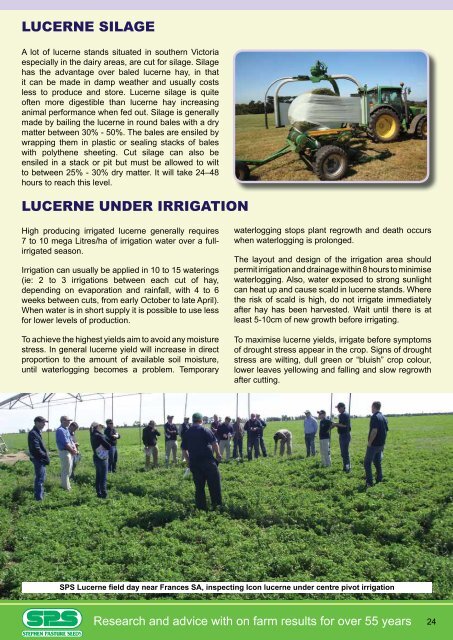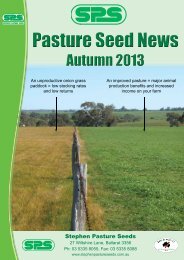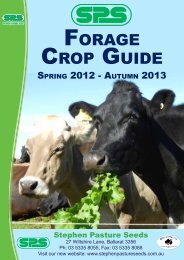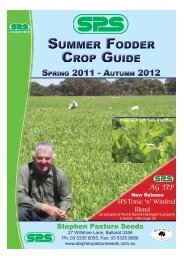Click here - Stephen Pasture Seeds
Click here - Stephen Pasture Seeds
Click here - Stephen Pasture Seeds
You also want an ePaper? Increase the reach of your titles
YUMPU automatically turns print PDFs into web optimized ePapers that Google loves.
LUCERNE SILAGE<br />
A lot of lucerne stands situated in southern Victoria<br />
especially in the dairy areas, are cut for silage. Silage<br />
has the advantage over baled lucerne hay, in that<br />
it can be made in damp weather and usually costs<br />
less to produce and store. Lucerne silage is quite<br />
often more digestible than lucerne hay increasing<br />
animal performance when fed out. Silage is generally<br />
made by bailing the lucerne in round bales with a dry<br />
matter between 30% - 50%. The bales are ensiled by<br />
wrapping them in plastic or sealing stacks of bales<br />
with polythene sheeting. Cut silage can also be<br />
ensiled in a stack or pit but must be allowed to wilt<br />
to between 25% - 30% dry matter. It will take 24–48<br />
hours to reach this level.<br />
LUCERNE UNDER IRRIGATION<br />
High producing irrigated lucerne generally requires<br />
7 to 10 mega Litres/ha of irrigation water over a fullirrigated<br />
season.<br />
Irrigation can usually be applied in 10 to 15 waterings<br />
(ie: 2 to 3 irrigations between each cut of hay,<br />
depending on evaporation and rainfall, with 4 to 6<br />
weeks between cuts, from early October to late April).<br />
When water is in short supply it is possible to use less<br />
for lower levels of production.<br />
To achieve the highest yields aim to avoid any moisture<br />
stress. In general lucerne yield will increase in direct<br />
proportion to the amount of available soil moisture,<br />
until waterlogging becomes a problem. Temporary<br />
waterlogging stops plant regrowth and death occurs<br />
when waterlogging is prolonged.<br />
The layout and design of the irrigation area should<br />
permit irrigation and drainage within 8 hours to minimise<br />
waterlogging. Also, water exposed to strong sunlight<br />
can heat up and cause scald in lucerne stands. W<strong>here</strong><br />
the risk of scald is high, do not irrigate immediately<br />
after hay has been harvested. Wait until t<strong>here</strong> is at<br />
least 5-10cm of new growth before irrigating.<br />
To maximise lucerne yields, irrigate before symptoms<br />
of drought stress appear in the crop. Signs of drought<br />
stress are wilting, dull green or “bluish” crop colour,<br />
lower leaves yellowing and falling and slow regrowth<br />
after cutting.<br />
SPS Lucerne field day near Frances SA, inspecting Icon lucerne under centre pivot irrigation<br />
Research and advice with on farm results for over 55 years<br />
24






